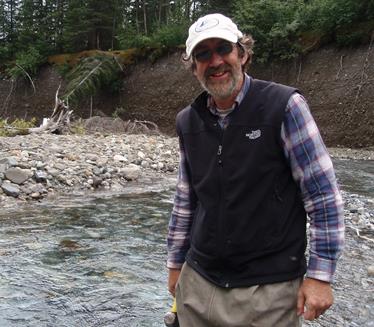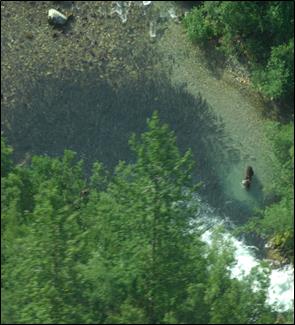What are the major factors affecting colonization of new streams in Glacier Bay?
Project Dates
Ongoing since 1977
Did You Know?
Ecological succession on land typically involves winners and losers—as succession progresses, species disappear and are replaced by others. In stream succession, by contrast, tolerance seems to be the model—most early colonizers remain, joined by newer arrivals.
Introduction

Sandy Milner’s study of ecological succession in streams is not only the longest-running research project in the park, but also the longest continuous study of primary succession in streams anywhere. It all started in 1974, when Sandy was pursuing a Master’s degree in hydrobiology at Chelsea College, University of London, and read a chapter called “A region reborn” in a Time/Life book about Alaska. Sandy was instantly captivated. He realized that the rapid recession of glaciers in Glacier Bay presented a unique opportunity to study the ecological development of streams. Three years later, his dream to organize an expedition of Chelsea College students to Glacier Bay became a reality; thirty-six years later, Sandy is still returning to Glacier Bay every summer.
Ecological succession is a key concept within ecology. This study has made a major contribution to our understanding of the main variables driving ecological succession in riverine environments.
Methods

Over the years this study has investigated various aspects of stream development using methods that include:
- Collecting invertebrates and other fauna through various netting and trapping methods and by picking them from stones
- Measuring variables such as water temperature, pH, color, and nitrogen and phosphorous content
- Counting spawning salmon and capturing juvenile salmonids using minnow traps
- Collecting invertebrates prior to, during and subsequent to peak redd digging
- Collecting vegetation, invertebrates and juvenile fish to determine if marine-derived nutrients from salmon carcasses are being incorporated into the food chain
- Examining nutrient retention by releasing leaves and salmon carcasses into the stream
- Preparing detailed maps and cross-sections to understand how geomorphological and habitat complexity increases over time
Findings
Interesting findings from this study include:
- Low water temperature is the major factor inhibiting colonization of young streams.
- Small winged insects called midges, carried by the wind, are the earliest colonizers. Even in the cold, harsh conditions of very young glacial streams, large numbers of their worm-like larvae can be seen clinging to rocks in the streambed.
- Dolly Varden and “stray” spawning pink salmon may colonize new streams within 10 years. Large populations of pink salmon can develop in a few generations.
- In young streams that lack pools, tributary streams or woody debris, salmon carcasses wash away, their nutrients lost.
- Redd digging by female salmon disrupts ecological succession and allows the persistence of “fugitive” species that are good dispersers but poor competitors.
- The presence of an up-stream lake is important in mitigating flooding, increasing water temperature and stabilizing the stream. However, many lakes become detached from the stream as watersheds develop.
- The presence of woody debris in the stream is also very important in retaining salmon carcasses, creating habitat and increasing stream productivity.
- The highest diversity of geomorphological habitat occurs in mid-aged streams (125-175 years).
- Aside from the very earliest colonizers, most species persist as succession progresses, supporting the model of succession known as tolerance.
The study has resulted in not only Sandy’s PhD dissertation, but six others (Flory, Monaghan, Phillips, McDermott, Veal, Klaar) and three more currently in the works (Malone, Clitherow and Sonderland). Twenty-seven papers have been published in scientific journals. Sandy is the only researcher to have presented at all four Glacier Bay science symposia.
Last updated: September 15, 2016
